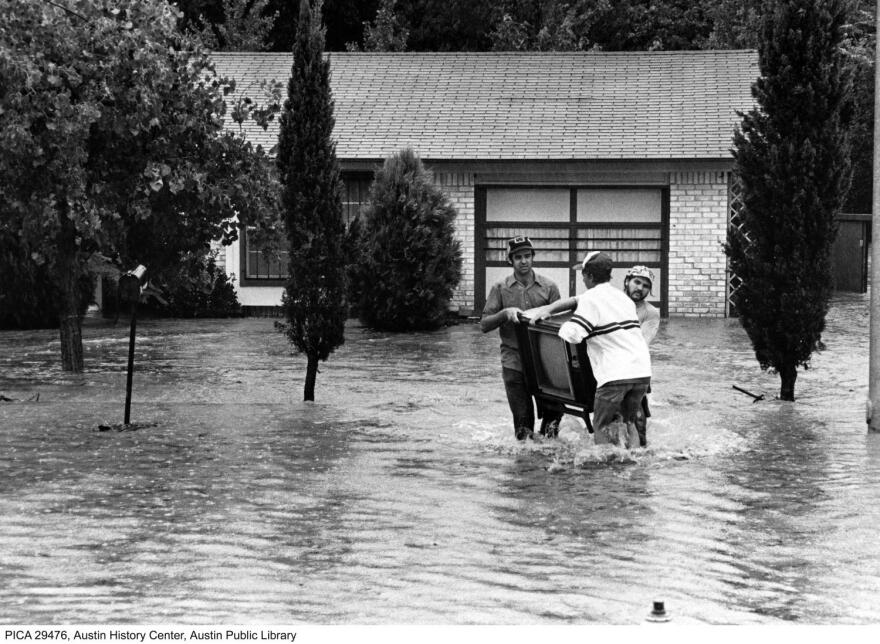Just when Austin was starting to think that drought might continue into the summer, the first raindrops fell � and kept falling.
Throughout Austin’s history, the city has fallen victim to many floods, caused by dam failure, excessive rain and tropical storm remnants.
Not only do these floods damage infrastructure � especially riverside homes and businesses � and cost local governments millions to recover, there are few major flooding events that don’t take lives. The recent disaster is no exception, and is one of the deadliest on record.
What is the deadliest flood in the Austin area’s history?
The were in 1843 and 1869, the latter being far worse. While incomplete records make it impossible to know how many lives were lost, historical accounts report constant rain for 64 hours, an estimated $3 million in damages ($70 million today) and all major bridges on the lower Colorado River destroyed.
In April of 1900, Austin's newly constructed dam failed, sending a 50-foot wall of water pouring through downtown. This flooding event left at least 50 dead, making it the second deadliest in the Austin area's history.

In , hard rain caused a flash flood sending debris gushing through Shoal Creek and Waller Creek, killing around 35 people � the third deadliest event on record.

Flooding continued to be a regularity for Central Texas in the 1900s, with at least three notable flooding events occurring just in the 1930s and three more again in the 1980s. Events like the 1981 Memorial Day flood, catastrophic for many buildings and homes, killed 13 people.

The recent July 4 weekend flood left at least 18 dead in AGÕæÈË°Ù¼ÒÀÖ and neighboring counties, as of July 17. It is the fourth deadliest in the Austin area's history â€� and the deadliest since the construction of the Highland Lakes reservoirs in the 1930s.

The deadliest local flooding event in recorded history took place in 1921.
Remnants of the Tampa Bay hurricane settled over Thrall, a small city outside of Taylor in Williamson County, starting a 24-hour downpour. Rivers overflowed throughout Central Texas from the constant rain. The flood claimed alone. The disaster also stands as the second deadliest flooding event in state history.
What is the deadliest flood in Texas history?
While many may think of the more infamous hurricanes of the past century, such as Harvey in 2017 or , those storms left far more homeless than dead. Harvey did cause the most damage in state history, though, costing over $125 billion.
The deadliest flood in Texas � and in modern American history for that matter � was the in 1900. The hurricane claimed at least 6,000 lives and likely thousands more. It also destroyed over 2,500 homes, damaging thousands more.

The 1921 San Antonio flooding that saw over 200 lives lost statewide is the second deadliest since 1900. The third deadliest is the , claiming nearly 180 lives.
The recent July 4 weekend flooding event � affecting multiple areas of Texas, in particular the Kerrville area � is the fourth deadliest in state history, with over 130 found dead.
How much water was in this flood?
Parts of the Highland Lakes region received as much as 22 inches of rainfall over the July 4 weekend, according to the Lower Colorado River Authority. To put that in perspective, Austin averages per year.
Lake AGÕæÈË°Ù¼ÒÀÖ took the brunt of the recent flood and rain, rising more than 30 feet to a , LCRA data shows. The far less deadly “Christmas Floodâ€� of 1991 raised Lake AGÕæÈË°Ù¼ÒÀÖ to its highest point ever at just over 710 feet, according to the Austin Water Center for Environmental Research.
So, why was this month's flooding event so deadly? Experts suggest the nature of flash floods � the Guadalupe River rising to � contributed to the dangerous flows that rushed through the Texas Hill Country.
In a striking parallel to the recent tragedy at Camp Mystic, the Guadalupe also , killing 10 teenagers who were trying to flee their summer camp as floodwaters rose.
For a region often called "Flash Flood Alley," the danger posed by unexpected downpours in Central Texas will only continue.














